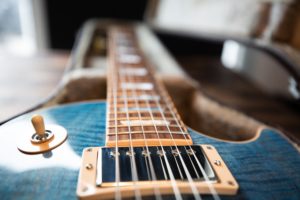JP BLOG
Share this
After a long stretch working on your guitar skills, you finally feel like you are starting to understand the guitar. But the guitar isn’t like riding a bike– if you get away from plucking those six strings, you will lose those months of hard work.
You have to be especially careful of this with bends, slides, and hammer ons. These are advanced concepts, so they’ll be the first to go if you let your foot off the gas. No need to fret– this simple guide will teach you everything you need to know.

Understanding Scales and Arpeggios
If you are fairly new to the world of bends, slides, hammer ons this is the place you want to start. A thorough understanding of scales and arpeggios is crucial.
If you don’t know already (or are only vaguely familiar) a scale is just an organized sequence of notes that help guitarists create riffs, solos, and chord progressions.
You’ve probably heard of some of the basic ones, like the Minor Pentatonic scale. An arpeggio is similar to a scale, except it breaks a chord into individual notes. For example, a C Major chord is made up of the notes C, G, E. To play a C Major arpeggio, play C, G, E, C in that order.
Groupings are also a crucial concept to grasp. Let JamPlay instructor Lance Ruby show you how in this free lesson, Getting It Under Our Fingers.
Riffing
Now that you have a solid understanding of scales and arpeggios, you are ready to start riffing. Speaking from personal experience, riffing is one of the most fun and rewarding parts of playing guitar, no matter what genre of music you prefer.
But just because you understand what makes up a riff doesn’t mean you will be able to just lay a killer one down. It takes more than just notes, you also need to have supreme timing, speed, and finger dexterity to nail it.
Lucky for you, I have some tips to have slaying riffs in no time.
Only experienced guitarists can improv successfully, so take time to plan out what you want your riff to sound like. I know the silence can be daunting, but don’t be afraid it’s a part of the creative process.
Also, don’t be afraid to use riffs from your favorite songs as inspiration. Your first few riffs aren’t going to make it out of your bedroom (or wherever you’re practicing) anyway. And, though it may not feel entirely satisfying, it’s the perfect place to start. You will be working on timing, speed, and finger dexterity while forming your own unique sound.
JamPlay has a great free video lesson, Interpretation, that will show you exactly how to make an existing piece of music your own.
My Finger’s Hurt, Help!
Here is your warning, all of this practice will hurt your fingers; It’s a part of playing guitar. Of course, your fingers will get used to heavy playing,
but no one enjoys burning, aching fingers. So, here is how to avoid as much pain as possible.

The easiest way to avoid finger pain is to keep your nails short. This is actually a double whammy as it will decrease pain and increase accuracy because your fingernails will no longer be getting in the way. Scheduling breaks while you play is another great way to keep your fingers from hurting too much. This will give you time to plan out your next riff. Lastly, ease up on the guitar strings a little bit. Pressure is required, but you shouldn’t be pressing so hard that your fingers turn white. Following these steps should have you well on your way to making the most of spring and mastering yet another guitar concept.
JamPlay is home to more than 500,000 guitarists with guitar lessons from world class instructor artists in every genre and for every interest to power up your guitar skill. Join at JamPlay.com.


